Search results for bud (497)
Nga Gyur Shed Dup Childrens’ Home (NSCH)
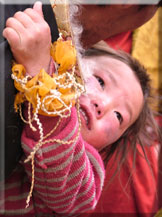
> ABOUT NSCF, Teachings, Activitys <
Nga Gyur Shed Dup Childrens’ Home (NSCH) is a non-profit social welfare home dedicated to provide care for orphans, abandoned and underprivileged children and those that living under the poverty line. With limited resources, it has been able to provide a decent home to abandoned and orphaned children, offering them family life, medical care, education and hope for the future.
Currently, there are 64 children receiving care and monastic education in NSCH. For the moment, we provide 16 bedrooms coupled with 2 double-decker beds to accommodate 4 children each room; a classroom, a scholar’s room and a kitchen.
Please contribute as much as your compassion to allow this noble cause in order for mankind to help each other and those in needs to live a normal life. The children urge for your help!
NSCH provides a unique opportunity for underprivileged and orphaned children to be sheltered and educated at an attached school, to be loved and cared for in a family-like environment.

The objectives of NSCH are:
- To provide food and housing in a secure and nurturing home environment.
- To provide quality education that emphasizes on ethical and spiritual development and academic achievement.
- To prevent them from engaging in anti-social activities and promote ethical values, human potential and sense of responsibility towards society and environment.
- To educate the children and community about health concerns and offer adequate medical care.
Tibet is a land of dreams, of temples and Himalayan expeditions, of ancient cities and picturesque villages and the birthplace of many enlightened Buddhist Masters (Mahasiddhas). This ancientness nation has inherited and retained a wholesome culture and unique customs.
This land of cultural diversity and rich tradition is also one of the poorest regions in the world and for much of its population, daily life is difficult. More than half of the people live below the poverty line. The harsh cold climate in this mystic land adds to the suffering of the Tibetan communities.
NSCF is a charitable organisation that receives no governmental funding and relies solely based on the charitable contributions of donors from all over the world to assist us in our effort to shelter and educate those children and elderly in need.
REIKI – SYSTEM OF NATURAL HEALING
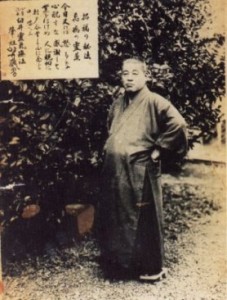
Reiki is a simple, gentle and very powerful way of healing. Reiki is also a spiritual path which can lead us into the inscrutable and ineffable mystery of the Universe. Many of us come to Reiki seeking healing, and never learn much about Reiki’s spiritual depth. Yet, these two aspects of Reiki – the healing and the spiritual – are intertwined. Just like heaven and earth meeting each other in the beautiful dance of time meeting eternity; so too in Reiki, our absolute, eternal essence expresses in the relative, constantly changing, physical aspect of our lives.
Within this dance of heaven and earth, time and eternity, physical and eternal, we are faced with an ongoing progression of choices about how we engage with our lives. Our karma, interest, commitment, capacity, (and some luck, or grace), will determine how we choose. And the way we choose will shape the story of Reiki we’ll eventually tell.
People come to Reiki for different reasons: some for a method to heal the physical body, for use with themselves or others. Others wish to grow in peace and tranquillity. Many seek knowledge of the unseen mystery behind the physical world. And maybe all of us seek a way to deal with the suffering and meaninglessness of everyday life, and the “dark nights” of our soul. Reiki is invaluable for all this.
As a healing method Reiki offers a simple, hands-on technology that anyone can learn to use. If that’s all you’re seeking, it should serve you well. But there is more.
As a spiritual path Reiki offers a collection of skillful methods to help us come to know our real nature – not merely as a nice intellectual idea – but a profoundly intimate, ever-deepening experience of mystery, totally and perfectly beyond anything our ordinary minds might manufacture or our concepts may grasp. In fact, all we can do speaking about this reality is to point to mystery, like fingers pointing to the moon. Ultimately, it is something we’ll know as our real nature and as the nature of all things.
While this goal may seem ambitious, there is no need to be intimidated. Through Reiki, you will gradually be introduced to knowledge. And as you become able to see more you’ll recognize yourself as completely whole and absolutely perfect, since the very beginning.
Reiki challenges the unreasonably low opinion we usually hold about our own potential. It challenges us
- To be as healthy, complete, and conscious as possible, in order to fully occupy our place and role in this life.
- To become so powerful, that we may be able to make our biggest contributions to this world from the privacy of our hearts, without anyone ever knowing about it.
- To be a fountain of peace in the midst of turmoil.
- To be a source of healing amid dis-ease.
- To be a centre of tranquillity in the chaos of everyday life.
- To be a place of love and beauty in the midst of fear and ugliness.
- To be caretakers of this world, and of all creation.
Reiki is one of the gifts we have to help us along this path. It comes in humble guise, and is exceedingly gentle. Yet there is power hidden here. Through Reiki we come to recognize our dignity, our magnificence and we’re challenged to uncover our hidden splendour. We recognize our responsibility to each other and to all of life. We recognize Universal assistance as our birthright, and the miracle of unfolding as our path.
During the training you will attempt to present Reiki in its basic precious magnificence. At the core of this is the transmission of the heart-essence of this teaching: the atmosphere of compassion and wisdom which is the essence of all enlightened beings, and the skilful reminders that this is the real nature of each and every one of us. Still, the responsibility for liberation through this knowledge always remains our own, with infinite support if we’re willing to ask for it.
Reiki is not a book, nor a workshop. Reiki is alive inside you: a living current of love, wisdom, power as fresh and new as it was when Dr Usui first “discovered” it; eternally new as the in and out-breath of the Universe. May it bring you great joy and bless all the world!
A History of Modern Reiki
After almost a century of very gradual growth, Reiki exploded onto the world scene during the last 5 years or so. Despite its great popularity, the history and origins of Reiki were shrouded in myth and mystery until the fairly recent emergence of several records describing its development. At last it is becoming possible to piece together a more coherent story of the origins and spirit of Reiki, as expressed by its founder, Mikao Usui.
The brilliance of Dr Usui was that he connected, distilled and codified various complex teachings to produce an essentially „universal“ system of healing and spirituality, largely devoid of cultural trappings, thus enabling the „Sacred Science“ to be used by anyone for the benefit of everyone.
> Meet REIKI Groups at facebook <
> Meet traditional REIKI and Dr. Usui Mikao Groups at facebook <
INTRO OF THE FIVE TIBETAN TRADITIONS
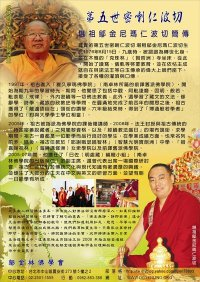
> BUDDHISM < and > BÖN <
Introductory History of the Five Tibetan Traditions
> TIBETAN LINEAGES OF MASTERS <
Introduction of Buddhism by Emperor Songtsen-gampo:
The history of the five Tibetan traditions of Buddhism and Bon. The four Buddhist traditions are Nyingma, Kagyu, Sakya, and Gelug, while the pre-Buddhist Tibetan tradition of Bon makes the fifth. Often we hear the syllable „pa“ at the end of these names. It means a follower of that tradition; for instance, Gelug pa means someone who follows the Gelug tradition.
To survey the history, we need to go back to the seventh century of the Common Era. At the beginning of that century, a king from Central Tibet named Songtsen-gampo conquered the Western Tibetan kingdom of Zhang-zhung and created the first unified Tibetan Empire. The custom in those days to unify an empire was for the king to marry princesses from nearby kingdoms – neighboring kings were less likely to attack the palaces where their daughters lived. Emperor Songtsen-gampo married princesses from China, Nepal, and Zhang-zhung. These princesses brought with them the religions of their native countries. The Chinese and Nepali princesses brought Buddhist texts and the Zhang-zhung princess brought her Bon beliefs. Bon was the Zhang-zhung native religion.
If we look from a Western historical viewpoint, Buddhism did not have much of an impact in this earliest period. The main development was that this first emperor built thirteen Buddhism temples in his domain. The map of Tibet was seen as a female demon lying on the earth. Choosing thirteen spots on the body of the demoness, like acupuncture points, the emperor commissioned temples built on each of them to subdue and control the energy of the demoness of Tibet. That is how Buddhism came to the Land of Snows.
To unify his empire further, Songtsen-gampo wished to have an alphabet for writing the Tibetan language. Thus, he sent his minister, Togmey-sambhota, to obtain the alphabet from Khotan – not from India, as is often explained in the traditional Tibetan histories. Khotan was a Buddhist kingdom north of Western Tibet in Central Asia. The route to Khotan that the minister took passed through Kashmir. When he arrived there, he discovered that the master he was going to meet in Khotan happened to be in Kashmir at the time. This is how the story evolved that the Tibetan writing system came from Kashmir. Orthographic analysis reveals that the Tibetan alphabet actually follows features distinctive only to the Khotanese script. Afterwards, there was much more contact with Buddhism in China and Khotan then there was with Indian Buddhism. The Bon religion, however, remained stronger in Tibet than Buddhism during this earliest period. It provided the ceremonies used in state rituals.
The Old Transmission Period (Nyingma)
In the mid-eighth century, another great emperor, Tri Songdetsen, ascended to the throne. He received a prophecy about future Buddhist teachings in Tibet and, in accord with this prophecy, he invited a great Buddhist teacher from India, Shantarakshita. Soon after the arrival of the Indian Abbot, a smallpox epidemic broke out. The court ministers, who were against all foreign influences in Tibet, blamed the smallpox on Shantarakshita and expelled him from Tibet. Before leaving, Shantarakshita advised the Emperor to invite Guru Rinpoche, Padmasambhava, to come and subdue the adverse conditions and problems. Tri Songdetsen followed this advice, and Padmasambhava came and rid Tibet of the interferences. The Emperor then invited Shantarakshita to return. There were already several Buddhist temples in the land, but now they built the first monastery in Tibet, at Samyay, just south of Lhasa. The Indian Abbot ordained the first monks.
Guru Rinpoche taught a little, but actually did not teach very much in Tibet. He mostly buried texts, thinking that the Tibetans at that time were not yet receptive. These texts were of the highest tantra teachings called dzogchen, the great completeness.
After this, many Chinese, Indian, and Zhang-zhung scholars worked together harmoniously at Samyay monastery, mostly compiling and translating texts from their own traditions. Soon, Buddhism was made the state religion. The Chinese had the largest influence at this time. Every second year, the Chinese emperor sent two monks to Samyay. The form of Buddhism the Chinese monks followed was Chan, the Chinese predecessor of Japanese Zen.
Shantarakshita predicted some conflict with the Chinese. Please keep in mind that the religious history did not happen in a vacuum; it happened in connection with the political history and there were a lot of wars between China and Tibet at this time. Shantarakshita said that they should invite his disciple, Kamalashila, to settle whatever problems might arise.
Meanwhile, Emperor Tri Songdetsen sent more Tibetans to India to bring back teachings and invite more Indians to his land. More texts were buried. Because there were so many wars with China and Central Asia and because the ministers were against any foreign influence in Tibet, it makes sense that there was a persecution of the Bonpos in Samyay and at the court. After all, the Bonpo faction was primarily from Zhang-zhung.
There was also a Dharma debate between Kamalashila, representing the Indians, and the Chinese representative. The Chinese lost. Of course, there was no way that a Chan master could defeat, in logical debate, a master in logic from India. It was no contest: Chan practitioners have no training in logic. For many reasons, one could postulate that the debate was a political move taken to provide an excuse for expelling the Chinese and for adopting Indian Buddhism as the main form of Buddhism in Tibet. Of all the kingdoms and empires neighboring Tibet, the Indians posed the least military threat.
I like to present history not from the standard devotional Tibetan point of view but a little bit more from a Western, scientific viewpoint, since I do have that training. I think it indicates a little more clearly what happened. It makes more sense.
Many more translations took place after this. In the early ninth century, under imperial sponsorship, the scholars compiled a Sanskrit-Tibetan dictionary and standardized the translation terms and style. It is quite interesting that the scholars did not include any tantra terms in the dictionary; tantra was already quite controversial.
In the mid-ninth century, the infamous persecution of Buddhism by the Emperor Langdarma took place. Rather than making Langdarma into the devil, as devotional histories tend to do, it may be more objective to see this persecution as a reaction to the abbots and monks at Samyay who were trying to assert too much influence on the government. Too much of the taxes raised by the state went for supporting the monasteries, and the economic burden had become untenable.
Actually, what Langdarma did was shut down the monasteries; it was not that he destroyed Buddhism. He did not destroy the Buddhist libraries, because Atisha found them when he came to Tibet a century later. Buddhism continued outside the monasteries. What had started before and continued during this so-called „old transmission period“ (old translation period) later became known as „the old tradition,“ the Nyingma tradition.
> Meet Ogyen Ling Buddhist Association at facebook <
> Meet Tulku Ogyen Rinpoche (Khentrul) Group at facebook <
> Meet Tulku Ogyen Rinpoche (Khentrul) personal site at facebook <
> ABOUT KHENTRUL:
THE VEDAS AND ANCIENT EGYPT
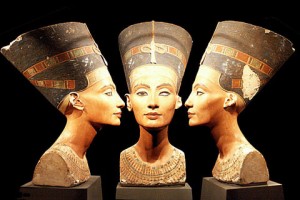
> THE INVOCATION OF THE GODDESS <
THE VEDAS AND ANCIENT EGYPT
By David Frawley
First published in the Hindu, one of India’s main national newspapers.
The Vedas as the Pyramids of the Mind
The Vedas represent a monumental spiritual literature, by far the largest that remains from the ancient world. We could therefore call the Vedas, `the pyramids of the ancient mind‘. The > Vedas < are the oldest record of the great dharmic traditions of the East, with not only the Hindu but also Buddhist, Jain, Sikh and Zoroastrian traditions part of the same greater stream of spiritual striving. Apart from the Biblical tradition, this dharmic or Indic tradition is one of the two dominant streams of world spirituality that has endured throughout the centuries and remains vital to the present day, as the global popularity of Yoga, Vedanta and Buddhism clearly reveals.
If we look at the Vedic tradition, we see that it was based upon an ancient priestly order that was extensive and sophisticated, comparable to the priestly orders of ancient Egypt or Babylonia. This priestly order was concerned not merely with rituals but also with spirituality, yoga, philosophy, medicine, astronomy and architecture that form the basis of the various Upavedas and Vedangas.
This spiritual culture of ancient India can easily be compared with that of ancient Egypt, which was similarly guided by extensive priestly orders, their sophisticated rituals and an emphasis of mysticism and magic. As ancient Egypt was arguably the spiritual center of the West in the ancient world, so India can be said to be the spiritual center of the ancient East.
> Meet Egypt Groups and Friends at facbook <
VEDIC PATH – MYTHS OF MEDITATION !
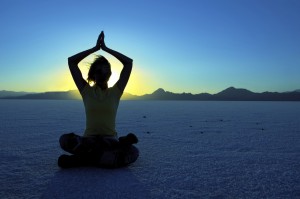
> Myths of Meditation! New light on Dhyana. <
By Yogi Baba Prem Tom Beal, Veda visharada, CYI, C.ay, C.va,
Upanishad
From Hindupedia, the Hindu Encyclopedia www.hindupedia.com
By P.R.Ramachander
The term > „Upanishad“ < literally means the inner or mystic teaching. It is derived from upa (near), ni (down) and s(h)ad (to sit), i.e., sitting down near, which refers to groups of pupils sitting near their teacher to learn from him the secret doctrine. In the serenity of forest hermitages, the Upanishad thinkers pondered on the problems of deepest concerns and communicated their knowledge to the capable pupils that sat near them.
Samkara derives the word Upanishad as a substitute from the root sad, ‚to loosen,‘ ‚to reach‘ or ‚to destroy‘ with Upa and ni as prefixes and kvip as termination. If this determination is accepted, Upanishad means brahma-knowledge by which ignorance is loosened or destroyed. The Upanishads are found in the concluding sections of the Vedas and are classified as Vedanta, or the end of the Vedas.
There are five Vedas and each of these five books has several Saaakas (Branches). Each Saaka has a Karma Khanda dealing with the actions to be performed and is made up of Mantras and Brahmanaas. The latter deals with Upasana or meditation and has Aranyakas * inside them for the benefit of those who have resorted to the quiet habitat of the forest to pursue their spiritual quest.
(*Literature in the ancient period was not fuelled by the urge to preserve history but was a complication of experiences and rules of worship. Most of the literature of this period was religious. (a) The Indigenous literature includes the Vedas, the Brahmanas, the Aryankas, the Upanishads, the Epics Ramayana and Mahabharatha, the Brahmashastras, the Puranas. The Buddhist and Jain literature gives knowledge of the traditions prevalent in those periods. The literature of this period are in Sanskrit Pali Prakrit. It gives us a knowledge about music, dance, painting architecture and administration of various kings.)
The Upanishads are found mostly in the Aranyaka section of the Vedas. The five Vedas have 1180 Saaakas and thus there should be 1180 Upanishads. Of these, what exists today is a collection of 108 Upanishads. The list of these 108 Upanishads is given in the Mukthikopanishad.
Out of the 108 Upanishads, only 10 have been commented upon by several Acharyas like > Adi Shankaracharya < . These are Ishavasya, Kena, Katha, Aithreya, Brihadaranyaka, Prashna, Mandukya, Taittireeya, Chandogya and Mundaka. These have also been popularized by many savants like Swami Vivekananda, Swami Chinmayananda etc. They all deal with highest category of philosophy and metaphysics. Because of this, there is a general impression that all Upanishads are texts of Hindu Philosophy. This is not true. There are Upanishads which even tell you how to wear the sacred ash, how to worship a particular God and so on. But the majority of them deal with methods of Yoga and Renunciation (Sanyasa).
Dhyana Bindhu Upanishad
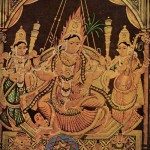
Om ! May He protect us both together; may He nourish us both together;
May we work conjointly with great energy,
May our study be vigorous and effective;
May we not mutually dispute (or may we not hate any).
Om ! Let there be Peace in me !
Let there be Peace in my environment !
Let there be Peace in the forces that act on me !
THE SACRED SYLLABLE „OM“ ACCORDING TO THE UPANISHADS (including dhyana bindu upanishad) , by TYS, Tradtional Yoga Studies, Georg Feuerstein, : > here < .
Aum (also Om, written in Devanagari as ॐ, in Chinese and Japanese as 唵, in Tibetan as ༀ, in Sanskrit known as praṇava प्रणव lit. „to sound out loudly“ or oṃkÄ�ra ओंकार lit. „oṃ syllable“) is a mystical or sacred syllable in the Indian religions, including Hinduism, Sikhism, Jainism and Buddhism, and in Bön.
Aum is commonly pronounced as a long or over-long nasalized close-mid back rounded vowel,) though there are other enunciations pronounced in received traditions. It is placed at the beginning of most Hindu texts as a sacred exclamation to be uttered at the beginning and end of a reading of the Vedas or previously to any prayer or mantra. The Mandukya Upanishad is entirely devoted to the explanation of the syllable. The syllable is taken to consist of three phonemes, a, u and m, variously symbolizing the Three Vedas or the Hindu Trimurti or three stages in life ( birth, life and death ). Though ostensibly in some traditions it is polysyllabic and vocalized as a triphthong, the Omkara is held to move through and contain all vowels possible in human speech.
The name Omkara, (Sanskrit: the syllable om) is taken as a name of God in the Hindu revivalist Arya Samaj. Similarly, the concept of om, called onkar in Punjabi, is found in Sikh theology as a symbol of God. It invariably emphasizes God’s singularity, expressed as Ek Onkar („One Omkara“ or „The Aum is One“), stating that the multiplicity of existence symbolized in the aum syllable is really founded in a singular God.
Read the full text: > HERE <
> Meet Adi Shankara Group at facebook <
LAMA JIGME´s FREE TIPS ON MEDITATION

FREE tips and teachings on Meditation and the Spiritual Path.
How could you help Feed a Buddhist Monk for just One dollar?
Please click > HERE < to learn how
Lama Jigme a refreshing encounter Episode Lama Jigme Gyatso is an ordained monk in an age when many are content to hide behind tradition, hearsay, dogma and circular reasoning it can be refreshing to encounter someone like him. Taking his teachers instructions to heart, he practices and transmits the Buddhas teachings in an essentialized and pragmatic manner that is as profoundly effective as it is deeply practical.
Who is Lama Jigme ?
Ordained as Lama Jigme Gyatso: Rime Manipa Tantrika, which translates as “Ocean of Courage Teacher; ” he is a Jewish-american born, Tibetan-buddhist: Monk, Teacher, Healer and Tantrika.
Lama Jigme was taught to be devoted to the Buddha of Compassion {Manipa} in a NON-sectarian manner {Rime} that practices Sutra’s union of compassion and insight as well as the union of Tantra’s paths of devotion, imagination and sensuality {Tantrika}.
In an age when many are content to hide behind tradition, hearsay, dogma and circular reasoning this controversial and unconventional teacher insists that a true Lama’s resume, credentials and letters of recommendation are the vastness of his Compassion, the profundity of his Insight and the power of his Effectiveness.
Lama Jigme Gyatso has had the very good fortune to receive teachings from every major Buddhist lineage of the Theravada, Mahayana and Tantric traditions.
Taking his Lama’s instructions to heart, he practices and transmits the Buddha’s teachings in an essentialized manner that is as profoundly effective as it is deeply practical.Interessen:Lama Jigme is playful and dynamicas well as loving and insightful.
Just as the alchemists of legend turned lead into gold, instructions received from this precious teacher can transform sorrow, anger, and fear into peace, love, joy and bliss.
Introduction into Trad. Tibetan Medicine

> Grundlagen der Tibetischen Medizin <
First Seminar Cycle “ Introduction into Traditional Tibetan Medicine “ successfull:
Around half of the participants of the seminar „Introduction into Traditional Tibetan Medicine“ were eager enough to take the exam at the end of the first seminar cycle. After having written their homework, the participants came from different parts of Austria (Vienna, Upper and Lower Austria, Styria, Carinthia) and Germany in order to accomplish the challenging 3-hour exam on March 21.
„The exam motivates me to deepen the knowledge. The Tibetan Medicine is rather complex and I would like to make use of it later on at my own small clinic. Therefore the studies are very important“, said doctor Z. from Vienna.
These introductory seminars delivered a „first sight“ into the diversity and depth of the Traditional Tibetan Medicine. Many of the participants want to continue and plan to attend the diploma course next year where they can extend their gained knowledge and get a deeper insight into the fields of „Tibetan Massage“ and/or „Gentle Therapies in the TTM“. In addition, special seminars for doctors are offered in the field of „Diagnostic Methods in the TTM“ where authentic Tibetan doctors will teach the art of pulse and urine diagnosis.
„I am happy that there is a big interest in the traditional Tibetan art of healing. This will help spread the TTM authentically in the West“, says Ven. Geshe Tenzin Dhargye, director of the Tibet Center. „A lot of our participants are doctors. Therefore we want to cooperate more closely with Austrian doctors in the future and thus want to cultivate the dialogue among experts“, explains Geshe T. Dhargye.
Tibetan medicine is a centuries-old traditional medical system that employs a complex approach to diagnosis, incorporating techniques such as pulse analysis and urinalysis, and utilizes behavior and dietary modification, medicines composed of natural materials (e.g., herbs and minerals) and physical therapies (e.g. Tibetan acupuncture, moxabustion, etc.) to treat illness.
The > Tibetan medical system < is based upon a synthesis of the Indian (Ayurveda), Persian (Unani), Greek, indigenous Tibetan, and Chinese medical systems, and it continues to be practiced in Tibet, India, Nepal, Bhutan, Ladakh, Siberia, China and Mongolia, as well as more recently in parts of Europe and North America. It embraces the traditional Buddhist belief that all illness ultimately results from the „three poisons“ of the mind: ignorance, attachment and aversion.
JNANA YOGA
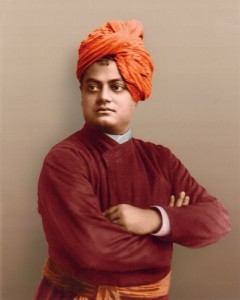
> COMPLETE WORK SRI RAMAKRISHNA, VIVEKANANDA <
> The Complete Works of Swami Vivekananda/Jnana-Yoga <
Swami Vivekananda (Bengali: স্বামী বিবেকানন্দ, Shami BibekÄ�nondo; Hindi: स्वामी विवेकानन्द, SvÄ�mi VivekÄ�nanda) (January 12, 1863–July 4, 1902), born Narendranath Dutta is the chief disciple of the 19th century mystic Sri Ramakrishna Paramahamsa and the founder of Ramakrishna Mission. He is considered a key figure in the introduction of Vedanta and Yoga in Europe and America and is also credited with raising interfaith awareness, bringing Hinduism to the status of a world religion during the end of the 19th century. Vivekananda is considered to be a major force in the revival of Hinduism in modern India. He is best known for his inspiring speech beginning with „sisters and brothers of America“, through which he introduced Hinduism at the Parliament of the World’s Religions at Chicago in 1893.
Swami Vivekananda was born in an aristocratic Kayastha family of Calcutta in 1863. His parents influenced the Swami’s thinking – the father by his rational mind and the mother by her religious temperament. From his childhood, he showed inclination towards spirituality and God realization. While searching for a man who could directly demonstrate the reality of God, he came to Ramakrishna and became his disciple. As a guru, Ramakrishna taught him Advaita Vedanta and that all religions are true, and service to man was the most effective worship of God. After the death of his Guru, Vivekananda became a wandering monk, touring the Indian subcontinent and getting a first-hand account of India’s condition. He later sailed to Chicago and represented India as a delegate in the 1893 Parliament of World Religions. An eloquent speaker, Vivekananda was invited to several forums in United States and spoke at universities and clubs. He conducted several public and private lectures, disseminating Vedanta, Yoga and Hinduism in America, England and a few other countries in Europe. He also established Vedanta societies in America and England. He later sailed back to India and in 1897 he founded the Ramakrishna Math and Ramakrishna Mission, a philanthropic and spiritual organization. Swami Vivekananda is regarded as one of India’s foremost nation-builders. His teachings influenced the thinking of other national leaders and philosophers, like Mahatma Gandhi, Jawaharlal Nehru, Subhas Chandra Bose, Aurobindo Ghosh, Sarvepalli Radhakrishnan, and Rabindranath Tagore.
THE PATH OF KNOWLEDGE –
Jnana Yoga according to Bhagavad Gita:
The aim of this article is to introduce the concepts of Jnana Yoga or the path of knowledge/wisdom in the light of the Bhagavad Gita…I will introduce only a few verses from the Gita to emphasize the approach to Jnana marga…at the same time, we will see practical methods for Jnana Yoga….The Gita is eminently a practice manual too.!
Introduction
The Hindu approach to spiritual evolution leading to liberation or moksha or Self-realization is one of the four major paths or yogas:
-
the path of knowledge or Jnana yoga,
-
the path of mind control or Raja Yoga ,
-
the path of devotion of Bhakti yoga and
-
the path of action/work or Karma yoga.
This is the common mode of classification, mostly derived from Swami Vivekanada’s lectures. Other yogas are minor variations of these four .
Of these, Bhakti Yoga and Karma Yoga have been given less importance in former times. The path of Knowledge, with focus on Hindu philosophy, has been in the forefront since the Vedic times…Some advaitins [non-dualists] would maintain that Karma yoga and Bhakti Yoga are preparatory steps or stepping stones [to purify the mind, chitta shuddi] and final liberation is possible only due to acquisition of Jnana or by Jnana Yoga as the final entry gate….[This was the stand taken by Shri Adi Sankara in Vivekachudamani too.]
The Jnana yoga is intellectually satisfying with abstract reasoning and can be devoid of rituals and formal worship of idols and symbols ;it is non-sectarian and asserts that the indwelling Soul or Atman and Self is the same in all.All these appeal to those who have a dislike for formal worship with rituals.[Yet devotion to Guru is essential in the Hindu context.]
Be that as it may, there are many saints and sages who would maintain that Bhakti yoga alone or Karma plus Bhakti is enough for final emancipation! I do not wish to dwell on this here because I have discussed this in greater detail in one of my books. [Refer: the Essence of the Bhagavad Gita…Pustak Mahal, New Delhi]
The significance of Jnana Marga
Among the four paths or yogas, Jnana marga is considered as the ‘direct’ path . If you consider the spiritual effort as that of climbing a mountain and reaching the summit, Jnana is like rock climbing without detours and winding roads.
Bhakti yoga can be likened to a sloping ,winding road leading to the summit and Raja yoga is like taking steep steps over rough stones. Thus Raja yoga is more difficult than Bhakti and Jnana is the most difficult of all.
Jnana yoga is admittedly difficult and certainly is meant for ‘dhiras’ –accomplished intellectuals with tremendous power of concentration for deep meditations on the abstract Self or Atman or Brahman. It is like rock climbing , with lot of training from expert mountain climbers and those with good physique…not for weaklings!…snd thode with ascetic bent of mind..
Therefore over the ages, there have been very few real jnanis .We are thrilled by the lives of great Jnanis or sages like Bhagawan Ramana or Sadashiva Brahmendra, Thayumanavar or Nisargadatta….again how many disciples they had who reached those heights?..may be a few again.
Bhagawan Ramana Maharshi stated that Jnana and the path of Self-enquiry or atma-vichara are really easy to encourage novices; , but among those who tread this path, many have fallen on the wayside many times. When you climb a rock face, a single mistake will result in crash to the bottom.!
I am not counting here excellent philosophers who may expound on the philosophy or nonduality [Advaita] and give lectures/satsanghs, but only those who have had deep experience of the Self; or reached Samadhi states.
It is safe to say that the path of Knowledge or Jnana is pretty difficult for this materialistic age, when ascetic methods are not even understood or appreciated, in the highly commercial atmosphere we live in.
What Jnana Yoga entails?
Swami Vivekananda had beautifully explained this path in his lectures, compiled into the book— ‘Jnana Yoga’ , published by Advaita Ashrama/RK mission/Vedanta societies.. I do not wish to elaborate on these, but point out a few things.
Jnana path entails two things: Viveka or discrimination and Vairagya or dispassion.
Viveka means distinguishing between unreal things [the phenomenal world, world of change ] and the Real, that is permanent [Self/Atman/Brahman].To get Viveka one may require intellectual analysis, cogitation, reflection and discussion….Satsangha would help ,but would not be always sufficient.
Vairagya or dispassion is to difficult to achieve…this is nonattachment to things of this world…little by little at first—the practice of sacrifice and renunciation….monkhood with severing of ties, with family ,society ,abandoning one’s property and possessions…Bhagwan Buddha [Sakyamuni], St Francis and Bhagwan Ramana are rare examples….Many jnanis may attain this stage in slow degrees too…
It is alright to talk of being in the world ,not of the world’ in a rhetorical sense, but not easy to practice…many so called Jnanis that I have come across still maintain contact with their kith and kin and friends , maintain personal bank accounts, own property—thereby making a mockery of real renunciation or sannyas in Indian /Hindu framework.
There are instances of great Jnanis making the break suddenly in a moment of intense vairagya or renunciation;they serve as beacon-lights for others and exemplify this path.
Let me add that in the Hindu context, only those who exhibit intense Vairagya would be respected in the Hindu society and acknowledged as real Jnanis, not those who profess enlightened state or give wonderful lectures or self-styled gurus.
A Jnani ,by definition ,has attained a state of equanimity or samatva;he looks upon pain and pleasure, friends and foes, glory and ignominy ,heat and cold, in the same light, without any feeling whatsoever. In other words, he does not exhibit attachment [ragha] or aversion [dvesha] against any one or any particular thing.
The message of the Bhagavad Gita.
Now let us turn to a few verses from the Gita.
The verses are most beautifully told in chapters 2,3,4,& 5.
-
That calm man who is the same in pain and pleasure ,whom these cannot disturb, alone is able to attain to immortality—O Arjuna. [2-15]
-
The Unreal never is. The real never is not.Men possessed of the knowledge of the Truth fully know both of these. [2-16]
-
This verse is the distilled essence of non-duality or advaita.
-
That by which all this is pervaded—that know for certain to be indestructible. None has the power to destroy this Immutable.[Self/Atman] [2-17]
-
Being steadfast in Yoga, perform actions , abandoning attachment, remaining unconcerned as regards success and failure. This even-minded is known as Yoga..[2-48]
-
Endued with this evenness of mind, one frees oneself in this life, alike from vice and virtue; devote thyself, to this yoga….Yoga is the very dexterity of work. (skill in action) [2-50]
-
Attachment [ragha] and aversion [dvesha] of the senses for their respective objects [of the senses] are natural; let none come under the sway; they are his foes. [3-34]
-
As fire is enveloped by smoke, as a mirror by dust, as an embryo by the womb, so is It covered by that [desires]. [3-38]
-
That man who lives devoid of longing, abandoning all desires, without the sense of “I” and “Mine” , he attains to peace. [2-71]
-
Mahatma Gandhi attached great importance to chapter 2 and chapter 3 of the Gita and also the latter portion of Ch 2 –verses 58-72 on the man of steady wisdom.
-
Whose actions are all devoid of plan [sankalpa] and desire for results, and whose actions are burnt by the fire of knowledge, him, the sages call wise. [4-19]
-
Verily there exists nothing in this world as purifying like knowledge. In good time, having reached perfection in yoga, one realizes that [knowledge]oneself in one’s own heart.. [4-38]
-
The place which is reached by the Jnanis is also reached by the karma yogis .He who understands knowledge and performance of actions as the same alone sees.(understands).
-
To those whose ignorance is destroyed by the knowledge of the Self—that knowledge of theirs, like the Sun, reveals the Supreme. [5-16]
-
Those who have their intellect absorbed in That, whose self is That, whose steadfastness is That, whose consummation is That, their impurities [sins] cleansed by knowledge, they go whence to non-return. [Moksha] [5-17]
-
With the heart unattached to external objects, he realizes the joy that is in the Self. With the heart devoted to the meditation of Brahman, he attains unending happiness.[5-21]
A careful study of these verses will clarify many things relating to Jnana Yoga.
> Meet Swami Vivekananda, Vedanta Groups & Fans at facebook <
> Meet Ramakrishna Groups at facebook <
NATURAL GARDENING
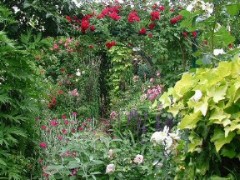
> MEDITATION AT JAPANESE GARDEN <
> Österreich´s Klostergärten & Gärten um Wien <
Natural gardens are especially valuable biotopes: colourful and manifold, they offer recreation, healthy crops and experiences next the front door.
They are oases for plant, animal and man. There they all develop a sense of well-being because of natural gardening: hedgehog and dragonfly, rare plants and colourful perennials. This is promoted by the action “Nature in garden – keeping healthy what keeps us healthy”.
No peat, no easily soluble mineral manure, no pesticides
These are three main criteria to be met by all natural gardens. Among 30 other arrangement and cultivation criteria at least 10 have to be fulfilled, too (e.g. diversity of species in natural grass turfs, orchards, use of rainwater, wild shrubbery etc.).
“Nature in garden” became one of the most successful environmental actions in Lower Austria during the last few years.
Awards to natural gardens
The enamel badge is not only a decoration at the garden door, but also shows the gratuity to garden owners for their natural gardening. This medal is bestowed on persons who keep to certain criteria of the action “Nature in garden”.
“Nature in garden” is an action of District president Sobotka, “die umweltberatung” Lower Austria (LA), the office of Lower Austrian administration – environment and area promotion department and of the LA agrarian authority.
Japanische Gärten sind ein Ausdruck der japanischen Philosophie und Geschichte. Solche Gärten findet man teilweise auf Privatgrundstücken, in Stadtparks, bei buddhistischen Tempeln oder Shintō-Schreinen sowie an historischen Sehenswürdigkeiten wie alten Schlössern. Ihnen wird nachgesagt, eine geheimnisvolle Ruhe und Schönheit zugleich auszustrahlen.
Eine Sonderform, der viele der berühmtesten japanischen Gärten angehören, ist der Zengarten im Kare-san-sui-Stil, bei dem auf Wasser und größere Pflanzen ganz verzichtet wird. Beliebt geworden sind diese Steingärten auch als Miniaturen in Form einer etwa 30 cm breiten Kiste für den Schreibtisch. Beim Tsukiyama-Stil (künstliche Hügel) werden dagegen Berge von Steinen und kleinen Hügeln dargestellt, und ein Teich repräsentiert das Meer. Es handelt sich also praktisch um eine Miniaturlandschaft. Japanese Garden Journal > here <
Musō Soseki, auch Musō Kokushi genannt (1275-1351)Musō Soseki (jap. 夢窓 疎石; * 1275 in Ise; † 30. September 1351), auch Musō Kokushi genannt, war ein japanischer Zen-Meister, Politikberater, Gartengestalter, Verfasser von Zen-Gedichten und Zen-Sprüchen, sowie Kalligraph. Er gilt als Begründer der japanischen Teezeremonie.
Musō Soseki (sein Mönchsname, der Geburtsname ist nicht bekannt) war einer der einflussreichsten Zenmeister und einer der bedeutendsten japanischen Gartengestalter der Frühzeit. Sein Leben und Werk markiert die Übergangsphase zwischen der Kamakura-Zeit und der Muromachi-Zeit (= Ashikaga-Zeit).
Ausbildung
Geboren ist er im Jahr 1275 in Ise, sein Vater zog aber schon 1278 mit ihm nach Kōshū (Schreibweise auch: Kai; in der heutigen Präfektur Yamanashi), damals einem Pilgerort der Adligen. Bereits im Alter von 6 Jahren (nach anderen Angaben 8 Jahren) begann er sich mit dem Buddhismus zunächst der Shingon-Richtung zu beschäftigen, befasste sich z.B. mit den Schriften ihres Gründers Kūkai (774-835). Im Alter von 19 Jahren (nach anderen Angaben im Jahr 1297) konvertierte er zur Tendai-Richtung (Elemente beider Richtungen integrierte er später in seine Schule). 1294 trat er nach Bestehen einer Aufnahmeprüfung ins Kloster Kennin-ji (jap.: ji = Tempel) in Kyoto ein, wo er bei Muin Zenshi (nach anderen Quellen: Yishan Yining [Schreibweise auch: I-shan I-ning, Issan Ichinei] (1247-1317), ein damals berühmter aus China emigrierter Zen-Priester und -lehrer, dessen Vorbild der Chan-Meister Huai Su (Tang-Zeit, 737 bis nach 798) und Meister der Sung-Zeit waren) , später auch bei Koho Kennichi (1241–1316) seine Ausbildung in der Rinzai-Richtung (= Zen-Buddhismus) erhielt. In Sosekis kalligraphischem Werk ist sowohl der Einfluss des Chinesen Kūkai als auch des Japaners Ichinei zu spüren, es unterscheidet sich hierin von Kalligraphien anderer zeitgenössischer Zen-Meister. Die Rinzai-Schule war eng mit dem Kaiserhaus und der Militärregierung verbunden.
> Meet Everything about Gardening Group at facebook <
> Meet ZEN Group at facebook <
> Meet Zen Zentrum Oberpfalz at facebook <
Tibetan Medicine, Spirituality, Compassion
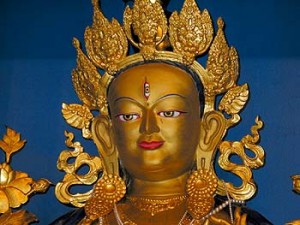
> CONGRESS – 10th anniversary of the New Yuthok Institute <
October 31 2009 (9h – 18h)
„Spirituality & compassion as cure of the body and mind“
Das > New Yuthok Institut < feiert dieses Jahr sein 10-jähriges Jubiläum. Aus diesem Anlass wird am 31. Oktober 09 ein Kongress in Mailand organisiert. Über ihre Erfahrungen mit Tibetischer Medizin im Westen berichten:
- Tibetische Medizin und Homöopathie, Dr. Victorine Cumero
- Beziehung zwischen Buddhismus und Tibetischer Medizin, Prof. Pasang Yonten Arya Tendi Sherpa
- Tibetische und Westliche Medizin, Dr. Med Walburg Maric’ Oehler
- Produkte der Tibetischen Medizin, Dr. Herbert Schwabl
- Tibetische Medizin und Onkologie, Dr. Alfredo Celano
- Mitgefühl und Tibetische Medizin als psychologische Therapie, Prof. Gioacchino Pagliaro
- Tibetische Medizin und alltägliche Probleme aus der Praxis, Dr. Simonetta Nicolai
- Präsentation ausgewählter Fälle, Dr. Tenzin Thupten
The New Yuthok Institute is an Association founded by Prof. Yonten Arya (T. Sherpa) with several medical doctors and psychologists to preserve and spread the age-old teachings of Tibetan Medicine.
This particular medical system is distinguished from all other Eastern Medicines because of its strong spiritual and psychological matrix linked to the connection initially created with Bon shamanism and, later and especially, because of its strong link to Tibetan Buddhism.
It is a well-known fact that Buddhism is at the center of Tibetan Medicine which began with the teachings of Buddha Shakyamuni, himself, and it is just this close and essential relationship with Buddhism which sets the Tibetan system apart from all others.
Tibetan Medicine, in addition to its high ethical values, gives us a detailed description of the mind, the mental states and how they function. Today, much of this large body of information has been scientifically validated by neuroscience. The Tibetan view takes not only the individual and biological aspects of the mind into account but also its energetic and spiritual dimension. It is this dimension which dictates how we view all things and how they take shape in our minds.
It is especially, though not only, for this reason that Tibetan Medicine has awakened great interest among the community of psychologists, psychiatrists and mental health workers.
Tibetan Medicine is also unique because it doesn’t isolate itself from medical-scientific views and, in fact, embraces and complements them to offer an extraordinary contribution not only because of the therapeutic results it achieves but also because of its ability to integrate with scientific medicine and with other complementary medicines.
Tibetan Medicine, today, provides the West with an extraordinary opportunity because TM can act as a bridge to unite the various scientific, medical and psychological disciplines and can provide a path to achieve the ‘humanization’ of medical care.
With this Congress, the New Yuthok Institute celebrates its tenth anniversary by presenting aspects of the important training it has provided to many psychologists, medical doctors, nurses, physiotherapists, naturopaths and health workers in general and the results it has achieved in the context of clinical applications.
> Geschichte der Tibetischen Medizin <
und die Modernen Aspekte der Tibetischen Medizin
Die Tibetische Medizin hat ihre Hauptwurzeln im Lande selbst und in der uralten Erfahrung und Geschicklichkeit des tibetischen Volkes, das seit jeher in enger Verbindung zur Natur gelebt hat und zu seinem Überleben in großer Höhe stets auf eigene Ressourcen angewiesen war. Im Laufe der letzten zweitausend Jahre hat aber auch die medizinische Weisheit anderer Länder und Zivilisationen Eingang in das einheimische System gefunden – entweder wurden neue Einsichten direkt und beabsichtigt übernommen oder durch natürliche gegenseitige Befruchtung der Kulturen über Jahrhunderte hinweg allmählich assimiliert. Nachfolgend einige wichtige Stationen
Seit Jahrtausenden entwickelt sich in Tibet eine medizinische Überlieferung, die als Bön-Tradition bekannt ist.
> TIBETAN TANTRIC YOGA AND LUEJONG <
Two day seminar
rLung, mind and physical Yoga (luejong)
Concepts and practice, level II
Prof. Pasang Y. Arya
November 07-08 2009
The Tibetan tantric yoga is a practice that has been done by Indian and Tibetan yogis for centuries, and is not like yoga usually practiced in the West. It is a practice of rLung (psychic wind) and exercise of the mind purely based on spiritual development, which was laid down by the tantric tradition of master Pundit Naropa and later masters. The exercice removes the negative energies from the channels and chakras by physical positions and movements which harmonize wind and mind and release inner stress and tension. Dedicated and genuine pratitioners may tame the wind, develop spiritual experience, and become able to control the mind and emotion. The life-long exercice with proper motivation and correct view can lead to the pure state of awakened Buddhahood. Generally the yoga technique basically helps stimulate the channels and chakras, and purifies the body/mind and promote the health.
Our main site will help you find the Palyul center closest to you and will introduce you to our teachers, their teachings, and teaching schedules.
Our mission is to uphold and preserve the teachings of the Buddha through study, practice and activity. Our goal is to make the teachings, particularly in the Palyul Nyingma tradition of Tibetan Buddhism, available to all.
> Yoga <
Our centers offer a complete course of study, prayer, and meditation practice for those who wish to follow the path to freedom. Our retreat centers offer places to focus on practice. Click for a guide to Palyul center locations around the world or select a center website from the menu at left.
> Meet Tibetan Medicine at facebook <
> Meet IASBS Communication Board Buddhist Studies at facebook <
> Meet Palyul Dhonyag Shedrub Ling at facebook <
ZEN ZENTRUM OBERPFALZ – KALIGRAPHIE

The Art of Calligraphy
The world of calligraphy in Buddhism is deep and wide. The art of calligraphy is a great teaching, just as a silent retreat or formal practice. The “I” will disappear while drawing. When the Dharma draws, then you will become the Dharma. When drawing Kwan Um, Poe Dae Hwa Sang or Han San, you become one with it. Everyone is welcome, no experiences required.
Cost/Date:
Fri. 20. November, 7:00 pm – 9:30 pm
Sat. 21. November, 6:30 am – 9:15 pm
Sun. 22. November, 6:30 am – 3:00 pm
Seminar fee: your generous donation (DANA), House fee: € 108.-
We are a small Zen (Korean: Seon) Buddhist community. The initial concept was to form a lay meditation group of Zen practitioners following the Korean Zen (Seon) Buddhist teachings. Our practice is influenced by the teachings of Zen Master Seung Sahn, Zen Master Kusan as well as other meditation teachers like Martine and Stephen Batchelor. We use Zen forms, yet are fluid in our ability to adapt to changes within the form.
Living in a sleepy town called Altenstadt, an Administrative District Oberpfalz, in Bavaria Germany, we use a less stringent approach to our practice, placing more emphasis on the development of loving kindness and compassion along with attentiveness to the spiritual growth of each community member. Our Sangha is from various professions and religious backgrounds. We dedicate our lives to religious practice, practice of the Dharma and beneficence to all beings. May all beings realize their true nature!
Take a good look at yourself,
all truths are within you.
To look for truth outside yourself is to search
for water outside of the ocean.
by Master Seongcheol (1912-1993)
Our center is a small apartment of approximately 60 square meters. It consists of a tea room (which is also used as the teacher’s room when a teacher is in residence), a fully-equipped kitchen, a bathroom, and of course the Dharma Room. Since the it is located on the ground floor of a house, one can exit to a grassy garden straight out of the tea room. The usage of this apartment was graciously donated by Gerlinde Grunt’s life partner, who despite being a Buddhist nor a Zen practitioner, saw the value and merit of giving rentable space free to the service of saving all beings from the mind’s afflictions. The center also has a small lending library of books, CD and DVD collection which is open to all those who seek a deeper commitment to their Zen practice.
> Meet Zen Zentrum Oberpfalz at facebook <
BHAJANS – Lieder der Freude und Liebe !
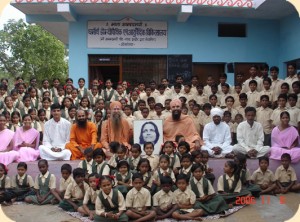
Plattform für indische Musik und Tanz in Österreich
> Bhakti Sangeet – Benefiz-Liederabend <
> School Project, Omkareshvar <
Mit Swami Mangalananda, Swami Gurusharanananda, Captain, Christian Weiss
Sa., 10.10.2009, 18:00 – 21:00, Yoga Zentrum Ganesha, 1090 Wien, Alserbachstrasse 2
Di., 13.10.2009, 19:30 – 22:00, „Gsunde Stubn“ 3500 Krems, Tel: 0676 3264219
Sa., 17.10. 2009, 18:00 – 21:00, Zentrum „Agartha“, 3100 St. Pölten, Mühlweg 16
So., 18.102099, 14:00 – 18:00, bei DDDr. Franz Langmayer, 1150 Wien Langmaisgasse 7
Swami Mangalananda und Swami Gurusharanananda leben im bedeutenden Pilgerort Omkareshwar im indischen Bundesstaat Madhya Pradesh und haben dort die einzige Schule des Gebiets (www.danamudra.org) aufgebaut. Die beiden sind auch exzellente Musiker und reisen nun das dritte Jahr in den Westen, um zu singen und ihre Aktivitäten bekannt zu machen. Diesmal treten sie auch im einzigartigen „Bockkeller“ – dem zauberhaften Spiegelsaal des Wiener Volksliedwerks – auf.
Sie bieten ein buntes Programm mit Liedern aus verschiedenen Traditionen Indiens mit authentischen Musikinstrumenten. Ihr ältester Schüler Captain begleitet sie mit einer Dholak-Trommel, Unterstützung gibt es auch wieder durch Christian Weiss mit seiner Tabla. – Kaum jemand kann sich der Lebensfreude dieser Musik entziehen. Zwischen den Liedern erzählen die Mönche amüsante und lehrreiche Anekdoten von indischen Weisen und es werden auch berührende Bilder aus ihrer Gegend gezeigt und Fragen über die Schule und ihre Aktivitäten beantwortet.
Traditionelle Indische Bhajans und Kirtans – Das ist jubelnde Liebe zum göttlichen Aspekt des Seins. Zwei Möche eines indischen Klasters (Omkareshwar/Narmada in Madhya Pradesh), beide grossardige und hingebungsvolle Musiker und Sänger, kommen nach dem grossen Erfolg ihrer beiden Europatourneen wieder nach Österreich, um ihre Freude am Gesang mit uns zu teilen.
ZITAT > DAVE STRINGER < : …“ Kirtan ist ein wertvoller Teil des Yoga. Das Wort Kirtan (sanskrit) bedeutet „singen“. Die gesungenen Texte sind kurze, einfache Mantras in Sanskrit und werden gut lesbar auf eine Wand projiziert. Sanskrit ist eine besondere Sprache; sie besteht aus den reinsten, klarsten und konzentriertesten Lauten, die die menschliche Stimme er-zeugen kann….“ INTERVIEW mit David Stringer im > YOGA AKTUELL <
Swami Mangalananda stammt aus einer amerkikanischen Musikerfamilie und ist seit dreissig Jahren Möch, Swami Gurusharananda ist der junge indische Direktor der Schule, die DANA MUDRA seit 2005 unterstützt. Die beiden werden uns auch über den spirtituellen Hintergrund der Lieder informieren. Ein berührender neuer Film über den alten Pilgerort Omkareshwar, seine Kinder und die dort von den Mönchen betriebenen Schule wird ebenfalls gezeigt. Für die muskiklische Begleitung sorgen das indische Harmonium und Tabla.
Der Erlös der Veranstaltungen ist für den Ausbau und den Betrieb der Schule bestimmt, die das Kloster in dieser entlegenen, armen Gegend errichtet hat. Damit sollen möglichst viele Kinder die Chance bekommen, aus dem Kreislauf der Armut auszubrechen.
Wie in den vergangen Jahren werden Swami Gurusharananda und Swami Mangalananda uns auch heuer wieder mit mitreissenden und inspirierenden Bhajans begeistern!
Der Eintritt ist frei, großzügige Spenden sind erbeten.
DANA MUDRA – “ Die gebende Hand “ ist die Geste, mit der in der indischen und tibetischen Kunst manche Gottheiten und Buddhas dargestellt werden. Ist das nicht ein schöner Name für eine Vereinigung, die das Geben, das Teilen auf Ihre Fahnen geschrieben hat ? www.danamudra.org
PATANJALI – DIE WURZELN DES YOGA
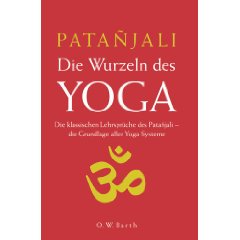
Die klassischen Lehrsprüche des Patanjali
von Bettina Bäumer
> YOGA & AYURVEDA von Vinod Verma <
Patanjalis Yoga-Sutras und ihre Anwendung auf Ayurveda
Patanjali (Sanskrit, पतञ्जलि, Patañjali, [pʌtʌɲʤʌlɪ]) war ein indischer Gelehrter, der die heute noch vollständig überlieferten Yoga-Sutras verfasst haben soll. In der indischen Mytholgie gilt er als Inkarnation des Schlangenkönigs Shesha. Über das Leben von Patañjali ist jedoch nichts bekannt, auch nicht wann er gelebt hat. Es ist nicht einmal sicher, ob er eine historische Persönlichkeit war. Indische Tradition setzt ihn mit dem Grammatiker gleichen Namens, der im 2. Jahrhundert vor Christus lebte, gleich. Da der Wortschatz des Grammatikers und des Schreibers jedoch stark von einander abweichen, gehen Indologen davon aus, dass es sich nicht um die gleiche Person handelt. Vielmehr sind sie aufgrund bestimmter Formulierungen, die sich auch im Spätbuddhismus finden, der Ansicht, das Werk sei im 4. oder 5. Jahrhundert nach Christus entstanden.
Wörtlich übersetzt bedeutet Sutra „Faden“. Das Yoga-Sutra ist also gewissermaßen ein Leitfaden für Yoga, der anders als die Bhagavadgita keine Rahmenhandlung besitzt und auch nicht gesungen wurde. Das Yoga-Sutra von Patañjali besteht aus 195 Sanskrit-Versen, in denen in hochkonzentrierter Form die Essenz des Yoga-Weges gebündelt ist. Es ist eine der ältesten Überlieferungen der Yoga-Tradition. Diese Form des Yoga wird als Raja Yoga oder Ashtanga Yoga (achtgliedriger Yoga) bezeichnet.
Kurzbeschreibung
Diese klassischen Lehrsprüche bilden die geistige Grundlage aller Yogasysteme. Sie stammen aus Überlieferungen, die wahrscheinlich im 2. Jahrhundert v. Chr. von Patañjali aufgezeichnet wurden. Die Vielfalt der Schulen und Richtungen, die sich im Laufe der Jahrhunderte entwickelt haben, geht auf diese älteste Quelle zurück. Die 195 prägnanten Sentenzen weisen den »königlichen Weg« zur vollkommenen inneren Befreiung durch rechte Erkenntnis. Er führt schrittweise , ohne Askese und gewaltsame Unterdrückung der Denkvorgänge, zum Verständnis der Wirklichkeit. Im Yoga leben heißt, unmittelbar, von Augenblick zu Augenblick, ohne hemmende Bindung an die Vergangenheit, ohne eingeschliffene Gewohnheiten oder eine überkommene Weltanschauung leben. P.Y. Deshpande, ein bekannter Schriftsteller und Publizist, hat sich über vierzig Jahre lang in Theorie und Praxis mit Yoga beschäftigt. Seine Einsichten, die Früchte dieser langjährigen Erfahrung, bilden zusammen mit den von Bettina Bäumer aus dem Sanskrit übertragenen Sutren ein unentbehrliches Standardwerk auf dem Gebiet des Yoga.
A G A M A
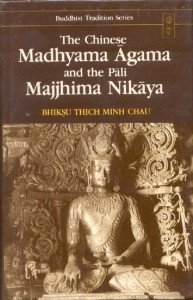
> The Chinese Madhyama Agama & the Pali Majjhima Nikaya <
> AGAMA IN BUDDHISM, JAINISM, HINDUISM <
A G A M A
By Jayaram V
The word „agama“ means authoritative scripture. It was used by > Panini < , the Sanskrit grammarian, as a linguistic term, to describe the formation of certain words. Tantric and Saiva tradition recognizes the agamas as the most authoritative and sacred texts on the methods of worshipping Saguna Iswara or the Brahman with qualities. In a limited sense the agamas are tantric texts containing the principles and practice of Saivism, presented in the form of a teaching by Lord Siva to His consort Parvathi. in contrast, the nigamas, another branch of sacred litetature, depict Parvathi as the teacher and Siva as its recipient. According to the Tantric tradition, the Vedas are nigamas.
Scholars believe that the earliest Agamas were composed during the later Vedic period, when the Vedic rituals were on the decline and Saivism, Vaishnavism and other religious sects were gaining ground. Not all agree with this contention. Some believe the earliest agamas to be much older than the Vedas. There is also an argument that some of the Upanishads and even some portions of the Bhagavadgita were renditions of preexisting agamas. Followers of Siva consider these texts superior to the Vedas. Unlike the Vedas, the Agamas are meant for all castes and sections of society, including women. While the many agamas belong to Saivism and recognize Siva as the Supreme deity, there are also Vaishnava and Shakti agamas which recognize Vishnu and Shakti respectively as the Supreme Iswara.
There is no unanimity as to the actual number of the agamas. Based upon who is recognized as the principal deity, the agamas are divided into Saiva, Vaishnava and Shakti or Tantra agamas. The Pancaratra Agamas and the Vaikanasa Agama belong to the Vaishnava tradition. The Saiva agamas, which contritubuted to the popularity of the southern school of Saiva Siddhanta philosophy and northern school of the Pratyabhijna system of Kashmir Saivism, are divided two distinct categories, namely the 28 Saiva Siddhanta Agamas and 64 Agamas belonging to both the Nakulisa Pasupatha and the Kashmiri Trika schools of Saivism. The > Kaula < , > Mishra < and> Samaya agamas < (and siddhanta texts) are considered to be part of the Shakti tradition. The Vaishnava agama is further divided into Pancharatra and Vaikanasa Agama. The smartas, who acknowledge the Vedas as the supreme and follow the Vedic tradtion, recognize the Agamas, but don’t necessarily adhere to them. In the Malay languages the word Agama literally means religion. The Agamas are also sometimes known as Tantras.
Buchtipp: Bettina Bäumer, Trika: > Grundthemen des kaschmirischen Sivaismus <
There is no unanimity as to what constitue the 28 Agamas of the Saiva Siddhanta schools. According to one classification, of the 28 agamas, ten represent the school of Advaita (monism) or Sivabheda and the rest the school of Vishishtadvaita (qualified monism)or Rudrabheda. The 28 Agamas are listed below:
LAMA JIGMES FREE TIPS
Lama Jigme a refreshing encounter Episode Lama Jigme Gyatso is an ordained monk in an age when many are content to hide behind tradition, hearsay, dogma and circular reasoning it can be refreshing to encounter someone like him. Taking his teachers instructions to heart, he practices and transmits the Buddhas teachings in an essentialized and pragmatic manner that is as profoundly effective as it is deeply practical.
Who is Lama Jigme ?
Ordained as Lama Jigme Gyatso: Rime Manipa Tantrika, which translates as “Ocean of Courage Teacher; ” he is a Jewish-american born, Tibetan-buddhist: Monk, Teacher, Healer and Tantrika.
Lama Jigme was taught to be devoted to the Buddha of Compassion {Manipa} in a NON-sectarian manner {Rime} that practices Sutra’s union of compassion and insight as well as the union of Tantra’s paths of devotion, imagination and sensuality {Tantrika}.
In an age when many are content to hide behind tradition, hearsay, dogma and circular reasoning this controversial and unconventional teacher insists that a true Lama’s resume, credentials and letters of recommendation are the vastness of his Compassion, the profundity of his Insight and the power of his Effectiveness.
Lama Jigme Gyatso has had the very good fortune to receive teachings from every major Buddhist lineage of the Theravada, Mahayana and Tantric traditions.
Taking his Lama’s instructions to heart, he practices and transmits the Buddha’s teachings in an essentialized manner that is as profoundly effective as it is deeply practical.Interessen:Lama Jigme is playful and dynamicas well as loving and insightful.
Just as the alchemists of legend turned lead into gold, instructions received from this precious teacher can transform sorrow, anger, and fear into peace, love, joy and bliss.